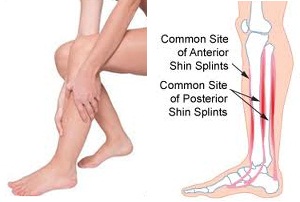People who are physically active or who engage in high impact sports activities are often prone to shin splints. These are also called medial tibial stress syndrome, which is characterized by pain along the large bone of the lower leg (tibia). The pain may also be felt behind this leg bone, and may result from excessive force that affects the bone and connective tissues. Sports activities that involve sudden stops like soccer, tennis or basketball as well as running can cause shin splints.
Symptoms of shin splints include soreness, tenderness and mild swelling along the inner portion of the leg. These symptoms may disappear when one stops running, but after some time pain may be felt continuously.

Shin Splints Causes and Risk Factors
Excessive force or overload on the lower leg bone and its connective tissues cause shin splints. Force overload commonly occurs when one runs downhill or runs up a tilted surface. Shin splints can also be a result of wearing old, worn-out shoes. Sports activities, involving frequent sudden starts and abrupt stops like basketball, cause intense force on the shinbone, leading to shin splints. Training errors and over exercising also predispose one to develop leg pains.
Certain factors increase one's risk for shin splints. These include:
- Starting a program in running for beginners
- Having flat feet or rigid foot arches
- Increasing workout intensity of high-impact sports
- Playing on hard surfaces
- Military training
Shin Splints Treatment
- Rest - Resting from high-impact sports and shifting to low-impact activities like swimming or cycling can give the shin a chance to heal. Using crutches when walking can also relieve the force on the shin and reduce pain.
- Apply Ice Packs - Ice packs may be applied on the painful leg for 15-20 minutes every three to four hours for a few days until pain and swelling subside. Be sure to use a cloth or thin towel to protect the skin by wrapping the ice packs.
- Reduce Swelling - Elevating the leg above the heart level and compressing it with a compression sleeve or elastic bandage can help decrease swelling. Make sure that the bandage is not too tightly wrapped so as to cause numbness or increased pain below the bandage.
- Take Over-the-Counter Medications - Pain relievers like Tylenol, Motrin or Advil are available in pharmacies and groceries to decrease pain and inflammation in the shin.
- Wear Suitable Shoes - Before engaging in sports, ask a doctor or sports professional about the proper footwear suitable to the activity, your foot type, and your stride.
- Try Arch Supports - To cushion your feet and diffuse stress on your lower leg bone, use arch supports, which may be available off-the-shelf arch in many sizes. Arch supports can also be custom-made by shoe professionals using a plaster cast mold of your foot.
- Stay Away from Cement - Hard surfaces like cement exert excessive force on the shinbone. Experts advise running on grass, asphalt, or crushed gravel instead. Aerobic exercises may also be done on carpeted floors or wooden floors instead of cement floors.
- Use Neoprene Sleeve - This provides compression and support to the leg with its anterior padding.
- Resort to Surgery - Surgery is rarely needed, but it may be used in severe cases not responsive to conservative treatment.
Shin Splints Prevention
Athletes and other active people can avoid shinbone pain by following these measures:
- Proper Footwear - Wear running shoes for running, tennis shoes for tennis, basketball shoes for playing basketball, and so on. Using only one pair of shoes for different activities should be avoided. Shoes must also be replaced when worn out.
- Insole - Place insoles to pad your shoes and reduce excessive impact from repeated pounding during running and other sports.
- Arch Supports - People with flat feet must support the foot arches to prevent shin splints.
- Cross Train - Alternate high impact sports activities with low-impact activities to reduce the risk for leg pain. Start slowly when doing new activities and increase intensity and duration gradually.
- Strength Training - Strengthen your leg muscles by doing toe raises. Do this in the standing position, slowly rising on the toes and slowly lowering the heels. Later, you can also hold some weights while doing toe raises. Train your leg muscles with leg raises and similar exercises.
- Running Places - Avoid Running on Concrete or on Hills. Run instead on flat ground, made of asphalt, grass or gravel.